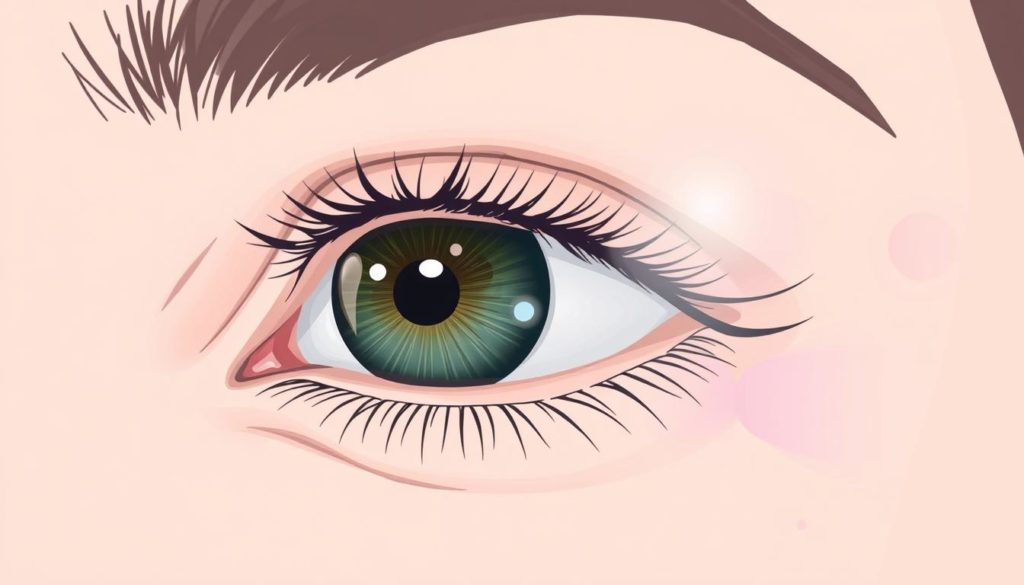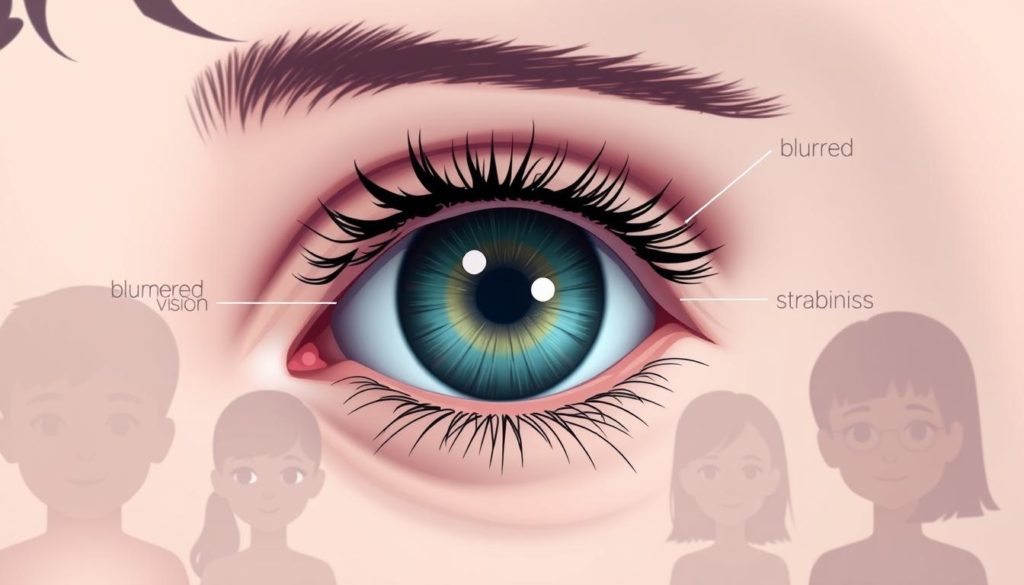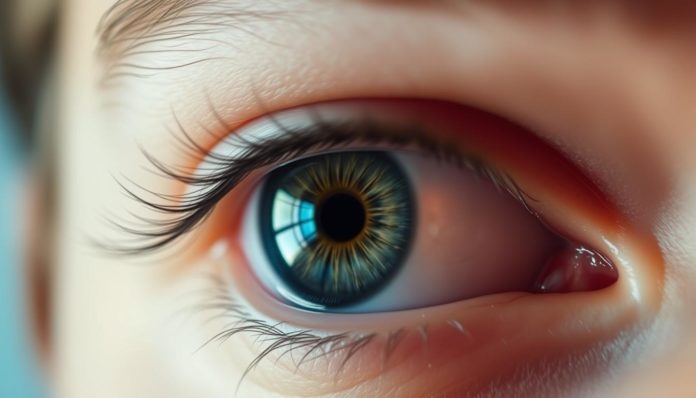Did you know that Amblyopia, also known as Lazy Eye, affects up to 3% of children in the United States? This vision disorder makes one eye unable to see clearly. If not treated, it can greatly affect a person’s life.
In this overview, we’ll cover the basics of Amblyopia. We’ll talk about its causes, symptoms, and why early treatment is key. We aim to show how managing this condition can lead to better vision for the future.
What is Lazy Eye (Amblyopia)?
Lazy eye, also known as amblyopia, is when one eye can’t see clearly, even with glasses or contacts. It starts from birth to age seven and is the top reason for poor vision in kids.

Definition of Amblyopia
is a vision problem where one eye can’t see as well as the other. It happens when the eyes don’t get the same visual experience early in life. This can mess up depth perception and sharp vision tasks.
Difference Between Lazy Eye and Strabismus
Knowing the is key since it’s often mixed up with amblyopia. Strabismus, or crossed eyes, means the eyes don’t line up right. They might turn in, out, up, or down. But, not all lazy eye comes from strabismus. This shows amblyopia is about poor vision in one eye, not eye misalignment like strabismus.
Lazy Eye Causes
Amblyopia, also known as Lazy Eye, has different causes for kids and adults. Knowing these causes helps in finding the right treatment.

Common Causes in Children
In kids, Amblyopia often comes from issues that mess with how their eyes work. These problems can be:
- Strabismus: When the eye muscles don’t line up right.
- Refractive errors: Big differences in how each eye sees things.
- Deprivation: Things like cataracts that block vision early on.
What Causes Lazy Eye in Adults?
Adults can also get Amblyopia, though it’s less common. The main reasons for this in adults are:
- Untreated childhood Amblyopia: If it wasn’t fixed when they were young, it can stick around.
- Visual deprivation: This can happen from things like cataracts or serious injuries.
- Neurological disorders: Problems in the brain that mess with how it sees things.
The main difference between Amblyopia in kids and adults is where it comes from. But both need quick and proper treatment to avoid lasting vision problems.
Symptoms of Lazy Eye
It’s important to know the symptoms of Lazy Eye to catch it early. Spotting the signs of Amblyopia in young kids or adults can help a lot. This can prevent serious vision problems later on.
Recognizing Early Signs
Spotting Amblyopia early is key to avoiding vision issues. The signs can be small, but they’re very important. Look out for squinting, closing one eye, or trouble with depth.
Also, if a child often gets headaches or struggles with reading, it might be a sign. These are early signs of Amblyopia.
Symptoms in Different Age Groups
Lazy Eye shows up in different ways for different ages. In infants and toddlers, watch for odd eye movements or one eye that seems to wander. For school-age children, trouble in school or sports could mean Amblyopia.
In adults, look for decreased vision in one eye, eye strain, or trouble with tasks that were once easy. Catching Amblyopia early can lead to better treatment.
Diagnosing Lazy Eye (Amblyopia)
Finding a lazy eye early is key to successful treatment. Doctors use many methods to diagnose amblyopia. These include vision screenings and eye exams by skilled professionals. These steps are vital to catch visual problems early.
During a vision screening, several tests are done to see how well each eye sees. Doctors might use eye charts, photoscreening, and automated devices. These tests help spot lazy eye in children early, preventing lasting vision issues.
A detailed eye exam is a trusted way to diagnose amblyopia. The ophthalmologist checks the child’s eye settings, eyelids, and eye movements. Special drops are used to dilate the pupils. This lets the doctor check for refractive errors like myopia or astigmatism, which can cause amblyopia.
Here’s a look at the common methods used during an eye examination:
| Method | Description |
|---|---|
| Visual Acuity Test | Measures clarity of vision using an eye chart. |
| Photoscreening | Uses a camera to take images of the eye, helping detect risk factors. |
| Autorefractors | Automated devices that measure the refractive error of the eyes. |
| Dilated Eye Exam | Involves eye drops that dilate the pupils, allowing for a detailed examination of the eye’s inner structures. |
Finding lazy eye early can lead to better and simpler treatments. Regular vision screenings and eye exams are important for kids. They help catch amblyopia early and manage it effectively.
Lazy Eye Treatment Options
There are different ways to treat Lazy Eye, depending on how severe it is and the patient’s age. Treatments can be non-surgical or surgical.
Non-Surgical Methods
Non-surgical treatments aim to strengthen the weaker eye and improve vision coordination. They include:
- Eyeglasses: Corrective lenses help treat refractive errors that cause Amblyopia.
- Patching: This method covers the stronger eye with a patch, making the weaker eye work harder.
- Atropine Drops: These drops blur the stronger eye’s vision, helping the weaker eye.
Surgical Interventions
If non-surgical treatments don’t work, Amblyopia surgery might be needed. Surgery aims to align the eyes and fix structural issues. Common surgeries include:
- Strabismus Surgery: This corrects eye misalignment by adjusting muscles.
- Lens Surgery: For cataracts or severe vision problems, lens surgery improves vision.
Choosing Amblyopia surgery depends on the patient’s suitability and vision problem. Each treatment plan is carefully made to ensure the best results.
Here’s a comparison of non-surgical and surgical treatments:
| Treatment Method | Type | Pros | Cons |
|---|---|---|---|
| Eyeglasses | Non-Surgical | Easy to use, cost-effective | Requires consistent wear |
| Patching | Non-Surgical | Strengthens weaker eye | Can be uncomfortable for children |
| Atropine Drops | Non-Surgical | Effective for younger children | Temporary blurred vision in stronger eye |
| Strabismus Surgery | Surgical | Realigns eyes, permanent solution | Invasive, recovery time |
| Lens Surgery | Surgical | Improves severe refractive errors | Invasive, risks associated with surgery |
Lazy Eye Exercises
Lazy Eye exercises are a key part of treating Amblyopia at home. They help improve vision and make the brain and eye work better together. Doing these exercises at home can really help your treatment.
Effective Home Exercises
There are many Lazy Eye exercises you can do at home. Some important ones include:
- Patch Therapy: Covering the stronger eye with a patch, making the weaker eye work harder.
- Penalty Therapy: Using atropine drops in the stronger eye to blur vision and help the weaker eye.
- Eye Tracking Exercises: Following a moving object with the weaker eye to improve focus and tracking.
- Near-Far Focus: Switching focus between close and distant objects to strengthen eye muscles.
How Often to Perform Exercises
How often you do Lazy Eye exercises is very important. It’s best to do them every day, several times, for short periods to avoid eye strain. Being consistent is crucial for the best results.
Keep an eye on how you’re doing and talk to a vision therapist or eye doctor. They can help you adjust how often you do the exercises for the best results.
Lazy Eye in Adults: Challenges and Solutions
Treating Amblyopia in adults is tough because their visual system is more set. Unlike kids, adults find it hard to change their brain’s pathways. Adult Amblyopia, or Lazy Eye, is a big problem for many. New treatments and therapies are being developed to help.
Traditional treatments don’t work as well for adults. Eye patches, for example, don’t help much. So, new therapies are being made just for adults. There’s been a lot of progress in this area, including:
- Vision Therapy: Eye exercises made for adults to improve their vision.
- Digital Therapeutics: Video games and apps to help the visual system.
- Ocular Pharmacology: New medicines to help the brain adapt.
Understanding Adult Amblyopia shows we need different treatments. These new methods tackle the unique problems adults face. Here’s a table comparing old methods with new ones:
| Treatment Method | Effectiveness on Children | Effectiveness on Adults | Challenges |
|---|---|---|---|
| Eye Patching | High | Low | Discomfort, Compliance |
| Vision Therapy | Moderate | Moderate | Needs Regular Sessions |
| Digital Therapeutics | Emerging | High | Access to Technology |
| Ocular Pharmacology | Experimental | High | Potential Side Effects |
New solutions are coming, giving hope to those with Lazy Eye in adulthood. The future for treating Amblyopia in adults looks bright. These new methods are showing promise and helping more people.
Lazy Eye in Children: Early Intervention and Care
When dealing with Child Amblyopia, early action is key. Catching it early helps prevent lasting vision issues. Parents are crucial in supporting their kids during this time. They need the right info and guidance.
Importance of Early Diagnosis
Finding Child Amblyopia early is crucial for treatment success. Doctors suggest eye tests for young kids. These tests can spot Lazy Eye and start treatment quickly.
Early detection means starting Lazy Eye care early. This can stop the problem from getting worse.
Parental Guidance and Support
Parents are essential in managing Child Amblyopia. Simple steps, like making sure the child wears glasses or patches, help a lot. Support and encouragement during Lazy Eye care exercises at home are important.
Also, keeping up with doctor visits and following treatment plans is key. This helps get the best results for the child.
Long-Term Outlook and Management
Early diagnosis and consistent treatment are key for managing amblyopia. The outlook for lazy eye is good if caught early. But, ongoing care is needed to keep vision sharp.
Regular eye exams and following treatment plans are crucial. This helps prevent vision loss. For adults with amblyopia, a tailored treatment plan is vital.
Vision therapy, along with glasses or surgery, can improve vision. A personalized approach is essential. It should change as the person’s needs do.
Living with lazy eye doesn’t have to limit daily life. The right strategies can help you stay active. Staying updated on treatments and eye health is important.
By embracing long-term management, you can improve your quality of life. This is true for those with amblyopia.
FAQ
What is Lazy Eye (Amblyopia)?
Lazy Eye, or Amblyopia, is a vision disorder. It makes one eye see poorly. It’s important to treat it to keep your vision good.
What causes Lazy Eye in children?
In kids, Lazy Eye can happen for a few reasons. It might be because their eyes don’t line up right or because their vision is different. It can also be caused by conditions like cataracts.
Can adults develop Lazy Eye?
Yes, adults can get Lazy Eye too. It’s less common but can happen from diseases like cataracts or injuries. Adult causes are different from kids’.
What are the early signs of Lazy Eye?
Look out for signs like poor depth perception and squinting. Kids might tilt their head or rub their eyes a lot. Catching these signs early is key.
How is Lazy Eye diagnosed?
Doctors use tests to find Lazy Eye. They do eye exams to check for it. Finding it early helps a lot.
What are the treatment options for Lazy Eye?
There are many ways to treat Lazy Eye. Kids might wear glasses or use eye drops. Sometimes, surgery is needed for more serious cases.
Are there exercises for Lazy Eye?
Yes, there are exercises to help. They help improve vision and eye coordination. Doing these exercises regularly can really help.
How do you manage Lazy Eye in adults?
Adults have special treatments for Lazy Eye. New therapies and vision therapy can help. These are different from what kids use.
Why is early intervention important for Lazy Eye in children?
Early treatment is very important for kids. It helps prevent vision problems later on. Catching it early and treating it right away is best.
How can parents support a child with Lazy Eye?
Parents can help a lot. Follow the doctor’s advice and make sure the child wears their glasses or patch. Doing eye exercises together is also helpful. Being positive and encouraging is key.
What is the long-term outlook for individuals with Lazy Eye?
The future looks different for everyone with Lazy Eye. It depends on how early and well they were treated. With the right care, many see a lot of improvement. Regular eye checks are important to keep vision good.


